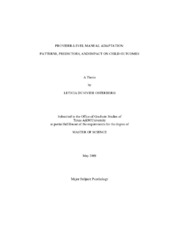| dc.description.abstract | Manualized, evidence-based treatments (EBTs) for children are being increasingly
incorporated in community mental health clinics. Yet, providers hold concerns about the
appropriateness of manuals for community populations, as suggested by the research of
Jensen-Doss, Hawley, Lopez and Osterberg. Such concerns could lead them to adapt EBTs
in the field, potentially diminishing or increasing their effectiveness. Therefore, it is striking
how little is known about provider-level manual adaptation in community settings. The
present study investigated the extent to which therapists mandated to use a manualized EBT
adapt the treatment in the field, including patterns, predictors and outcomes of adaptation. A
typology of provider-level manual adaptation was created to describe sessions double-dipped
(i.e., repeated), skipped, or flipped (i.e., delivered in reverse order).
Patterns of manual adaptation used by a sample of 38 community therapists treating
288 depressed youths with Lewinsohn and colleagues? Adolescent Coping with Depression
course (CWD-A) were described. Hierarchical Linear Modeling was used to identify which
client and therapist characteristics predict manual adaptation, and whether adaptation is
associated with greater improvement or worsening in youths? therapy outcomes.
Adaptation was widespread and largely unsystematic, with no significant client predictors of repeats or flips. Sessions were skipped more often for youths belonging to
families with higher income and youths with greater pre-treatment symptom severity, but less
often for Hispanic and Asian youths relative to Caucasians. A significant portion of
variability in adaptation was attributable to therapists, who showed habits in manual
adaptation: therapists with more years of experience working at the clinics double-dipped
sessions more often, and Hispanic therapists flipped sessions much less often than Caucasian
therapists did. Finally, adaptation was significantly related with outcomes, such that doubledips
were associated with worsened symptom severity, skips were associated with improved
symptom severity, and flips were associated with worsened functioning.
Given that these data suggest manualized EBTs are likely to undergo vast adaptation
in community settings, and that such adaptation is related to client outcomes, further research
is necessary to better inform practitioners about when each type of manual adaptation may be
appropriate. Practical implications for implementation efforts are discussed. | en |


